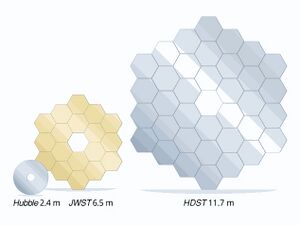Astronomy:High-Definition Space Telescope
The High-Definition Space Telescope (HDST) is a concept study of a space observatory that would be located at the Sun-Earth L2 Lagrangian point. The HDST study was published by the Association of Universities for Research in Astronomy (AURA) on July 6, 2015.[1] If selected for funding, it may launch sometime in the 2030s.[2] The HDST and the ATLAST are competing concepts to become LUVOIR,[3][4] managed by NASA's Large Strategic Science Missions program.
Overview

The HDST would be composed of 36 mirror segments with an aperture of 11.7 m (38 ft), offering images 5 times sharper than the Hubble Space Telescope.[2] The HDST would work at ultraviolet, visible and near-infrared wavelengths.[2]
The HDST is proposed to be parked at the Sun-Earth L2 Lagrangian point, orbiting the Sun about a million miles from Earth. HDST would be large enough to find and study the dozens of Earthlike planets in our nearby neighborhood. It could resolve objects such as the nucleus of a small galaxy or a gas cloud on the way to collapsing into a star and planets.[1]
HDST would be equipped with an internal coronagraph, a disk that blocks light from the central star, making a dim planet more visible, and perhaps eventually a starshade that would float kilometers out in front of it to perform the same function.[5] Initial cost estimates are approximately $10 billion.[5]
The case in favor of the telescope is made in a report entitled "From Cosmic Birth to Living Earths", on the future of astronomy commissioned by AURA, which runs the Hubble and other observatories on behalf of NASA and the National Science Foundation.[6]
The AURA group is using the report to start the selection process by which major scientific projects are chosen and funded. Every 10 years, a committee of the National Academy of Sciences surveys the astronomical community and produces a prioritized wish list for the next decade. This survey, which happens next in 2020, provides a guide for Congress and NASA.[5]
References
- ↑ 1.0 1.1 "AURA Releases Study of Future Space Telescope". http://www.aura-astronomy.org/news/news.asp?newsID=360. Retrieved 2015-07-24.
- ↑ 2.0 2.1 2.2 "High Definition Space Telescope — Hubble’s Successor?". http://www.skyandtelescope.com/astronomy-blogs/the-high-definition-space-telescope-hubbles-successor/. Retrieved 2015-07-24.
- ↑ "Extension of ATLAST/LUVOIR's Capabilities to 5 Microns, or Beyond". 14 May 2016. arXiv:1605.04367 [astro-ph.IM].
ATLAST and HDST can be thought of as possible implementations of LUVOIR.
- ↑ Cofield, Calla (1 February 2016). "NASA's Next Great Space Telescope: The Quest Begins". Space.com. https://www.space.com/31778-nasa-next-great-space-telescope.html. "One of the most recent such proposals has been named the "High Definition Space Telescope," (HDST), but the general concept is called LUVOIR (Large Ultraviolet Visible Infrared)."
- ↑ 5.0 5.1 5.2 Overbye, Dennis (2015-07-13). "The Telescope of the 2030s". The New York Times. ISSN 0362-4331. https://www.nytimes.com/2015/07/14/science/space/the-telescope-of-the-2030s.html.
- ↑ "AURA Report". http://www.hdstvision.org/report. Retrieved 2015-07-24.
External links


